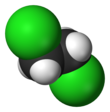| |||
| Names | |||
|---|---|---|---|
| Preferred IUPAC name
1,2-Dichloroethane | |||
| Other names
Ethylene dichloride
Ethylene chloride 1,2-DCA 1,2-DCE DCE[1] Ethane dichloride Dutch liquid, Dutch oil Freon 150 | |||
| Identifiers | |||
3D model (JSmol)
|
|||
| 3DMet | |||
| 605264 | |||
| ChEBI | |||
| ChEMBL | |||
| ChemSpider | |||
| DrugBank | |||
| ECHA InfoCard | 100.003.145 | ||
| EC Number |
| ||
| 49272 | |||
| KEGG | |||
PubChem CID
|
|||
| RTECS number |
| ||
| UNII | |||
CompTox Dashboard (EPA)
|
|||
| |||
| |||
| Properties | |||
| C2H4Cl2 | |||
| Molar mass | 98.95 g·mol−1 | ||
| Appearance | Colorless liquid | ||
| Odor | characteristic, pleasant chloroform-like odor[2] | ||
| Density | 1.253 g/cm3, liquid | ||
| Melting point | −35 °C (−31 °F; 238 K) | ||
| Boiling point | 84 °C (183 °F; 357 K) | ||
| 0.87 g/100 mL (20 °C) | |||
| Viscosity | 0.84 mPa·s at 20 °C | ||
| Structure | |||
| 1.80 D | |||
| Hazards | |||
| Occupational safety and health (OHS/OSH): | |||
Main hazards
|
Toxic, flammable, possibly carcinogenic | ||
| GHS labelling: | |||
  
| |||
| Danger | |||
| H225, H302, H315, H319, H335, H350 | |||
| P201, P202, P210, P233, P240, P241, P242, P243, P261, P264, P270, P271, P280, P281, P301+P312, P302+P352, P303+P361+P353, P304+P340, P305+P351+P338, P308+P313, P312, P321, P330, P332+P313, P337+P313, P362, P370+P378, P403+P233, P403+P235, P405, P501 | |||
| NFPA 704 (fire diamond) | |||
| Flash point | 13 °C (55 °F; 286 K) | ||
| Explosive limits | 6.2–16%[2] | ||
| Lethal dose or concentration (LD, LC): | |||
LC50 (median concentration)
|
3000 ppm (guinea pig, 7 h) 1000 ppm (rat, 7 h)[3] | ||
LCLo (lowest published)
|
1217 ppm (mouse, 2 h) 1000 ppm (rat, 4 h) 3000 ppm (rabbit, 7 h)[3] | ||
| NIOSH (US health exposure limits): | |||
PEL (Permissible)
|
TWA 50 ppm C 100 ppm 200 ppm [5-minute maximum peak in any 3 hours][2] | ||
REL (Recommended)
|
Ca TWA 1 ppm (4 mg/m3) ST 2 ppm (8 mg/m3)[2] | ||
IDLH (Immediate danger)
|
Ca [50 ppm][2] | ||
| Related compounds | |||
Related haloalkanes
|
Methyl chloride Methylene chloride 1,1,1-Trichloroethane | ||
Related compounds
|
Ethylene 1,1-Dichloroethane Vinyl chloride | ||
| Supplementary data page | |||
| 1,2-Dichloroethane (data page) | |||
Except where otherwise noted, data are given for materials in their standard state (at 25 °C [77 °F], 100 kPa).
| |||
The chemical compound 1,2-dichloroethane, commonly known as ethylene dichloride (EDC), is a chlorinated hydrocarbon. It is a colourless liquid with a chloroform-like odour. The most common use of 1,2-dichloroethane is in the production of vinyl chloride, which is used to make polyvinyl chloride (PVC) pipes, furniture and automobile upholstery, wall coverings, housewares, and automobile parts.[4] 1,2-Dichloroethane is also used generally as an intermediate for other organic chemical compounds, and as a solvent. It forms azeotropes with many other solvents, including water (at a boiling point of 70.5 °C or 158.9 °F or 343.6 K) and other chlorocarbons.[5]
- ^ Staff writer. "Standard Abbreviations and Acronyms" (PDF). The Journal of Organic Chemistry.
DCE: 1,2-dichloroethane
- ^ a b c d e NIOSH Pocket Guide to Chemical Hazards. "#0271". National Institute for Occupational Safety and Health (NIOSH).
- ^ a b "Ethylene dichloride". Immediately Dangerous to Life or Health Concentrations (IDLH). National Institute for Occupational Safety and Health (NIOSH).
- ^ "Toxic Substances – 1,2-Dichloroethane". ATSDR. Retrieved 23 September 2015.
- ^ Manfred Rossberg, Wilhelm Lendle, Gerhard Pfleiderer, Adolf Tögel, Eberhard-Ludwig Dreher, Ernst Langer, Heinz Rassaerts, Peter Kleinschmidt, Heinz Strack, Richard Cook, Uwe Beck, Karl-August Lipper, Theodore R. Torkelson, Eckhard Löser, Klaus K. Beutel, Trevor Mann "Chlorinated Hydrocarbons" in Ullmann's Encyclopedia of Industrial Chemistry. 2006, Wiley-VCH, Weinheim. doi:10.1002/14356007.a06_233.pub2.


